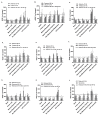Do Autophagy Enhancers/ROS Scavengers Alleviate Consequences of Mild Mitochondrial Dysfunction Induced in Neuronal-Derived Cells?
- PMID: 34072255
- PMCID: PMC8197898
- DOI: 10.3390/ijms22115753
Do Autophagy Enhancers/ROS Scavengers Alleviate Consequences of Mild Mitochondrial Dysfunction Induced in Neuronal-Derived Cells?
Abstract
Mitochondrial function is at the nexus of pathways regulating synaptic-plasticity and cellular resilience. The involvement of brain mitochondrial dysfunction along with increased reactive oxygen species (ROS) levels, accumulating mtDNA mutations, and attenuated autophagy is implicated in psychiatric and neurodegenerative diseases. We have previously modeled mild mitochondrial dysfunction assumed to occur in bipolar disorder (BPD) using exposure of human neuronal cells (SH-SY5Y) to rotenone (an inhibitor of mitochondrial-respiration complex-I) for 72 and 96 h, which exhibited up- and down-regulation of mitochondrial respiration, respectively. In this study, we aimed to find out whether autophagy enhancers (lithium, trehalose, rapamycin, and resveratrol) and/or ROS scavengers [resveratrol, N-acetylcysteine (NAC), and Mn-Tbap) can ameliorate neuronal mild mitochondrial dysfunction. Only lithium (added for the last 24/48 h of the exposure to rotenone for 72/96 h, respectively) counteracted the effect of rotenone on most of the mitochondrial respiration parameters (measured as oxygen consumption rate (OCR)). Rapamycin, resveratrol, NAC, and Mn-Tbap counteracted most of rotenone's effects on OCR parameters after 72 h, possibly via different mechanisms, which are not necessarily related to their ROS scavenging and/or autophagy enhancement effects. The effect of lithium reversing rotenone's effect on OCR parameters is compatible with lithium's known positive effects on mitochondrial function and is possibly mediated via its effect on autophagy. By-and-large it may be summarized that some autophagy enhancers/ROS scavengers alleviate some rotenone-induced mild mitochondrial changes in SH-SY5Y cells.
Keywords: ROS scavengers; autophagy enhancers; bipolar disorder; mitochondrial dysfunction; rotenone.
Conflict of interest statement
All authors declare no conflict of interest.
Figures






Similar articles
-
Does treatment with autophagy-enhancers and/or ROS-scavengers alleviate behavioral and neurochemical consequences of low-dose rotenone-induced mild mitochondrial dysfunction in mice?Mol Psychiatry. 2023 Apr;28(4):1667-1678. doi: 10.1038/s41380-023-01955-x. Epub 2023 Jan 23. Mol Psychiatry. 2023. PMID: 36690794 Free PMC article.
-
Enhanced translocation of TRIM32 to mitochondria sensitizes dopaminergic neuronal cells to apoptosis during stress conditions in Parkinson's disease.FEBS J. 2024 Jun;291(12):2636-2655. doi: 10.1111/febs.17065. Epub 2024 Feb 5. FEBS J. 2024. PMID: 38317520
-
The Effect of Neuronal CoQ10 Deficiency and Mitochondrial Dysfunction on a Rotenone-Induced Neuronal Cell Model of Parkinson's Disease.Int J Mol Sci. 2024 Jun 16;25(12):6622. doi: 10.3390/ijms25126622. Int J Mol Sci. 2024. PMID: 38928331 Free PMC article.
-
Oxidative stress response elicited by mitochondrial dysfunction: implication in the pathophysiology of aging.Exp Biol Med (Maywood). 2013 May;238(5):450-60. doi: 10.1177/1535370213493069. Exp Biol Med (Maywood). 2013. PMID: 23856898 Review.
-
Analysis of Mitochondrial Dysfunction by Microplate Reader in hiPSC-Derived Neuronal Cell Models of Neurodegenerative Disorders.Methods Mol Biol. 2022;2549:1-21. doi: 10.1007/7651_2021_451. Methods Mol Biol. 2022. PMID: 35347693 Review.
Cited by
-
Association of ATG5 gene polymorphism with Parkinson's disease in a Han Chinese population.Acta Neurol Belg. 2022 Aug;122(4):1049-1056. doi: 10.1007/s13760-021-01814-y. Epub 2021 Oct 18. Acta Neurol Belg. 2022. PMID: 34661876 Free PMC article.
-
Does treatment with autophagy-enhancers and/or ROS-scavengers alleviate behavioral and neurochemical consequences of low-dose rotenone-induced mild mitochondrial dysfunction in mice?Mol Psychiatry. 2023 Apr;28(4):1667-1678. doi: 10.1038/s41380-023-01955-x. Epub 2023 Jan 23. Mol Psychiatry. 2023. PMID: 36690794 Free PMC article.
-
Protective Effect of Photobiomodulation against Hydrogen Peroxide-Induced Oxidative Damage by Promoting Autophagy through Inhibition of PI3K/AKT/mTOR Pathway in MC3T3-E1 Cells.Oxid Med Cell Longev. 2022 Nov 22;2022:7223353. doi: 10.1155/2022/7223353. eCollection 2022. Oxid Med Cell Longev. 2022. PMID: 36457727 Free PMC article.
-
Exploring the Neuroprotective Effects of Lithium in Ischemic Stroke: A literature review.Int J Med Sci. 2024 Jan 1;21(2):284-298. doi: 10.7150/ijms.88195. eCollection 2024. Int J Med Sci. 2024. PMID: 38169754 Free PMC article. Review.
-
Tartary Buckwheat Peptides Prevent Oxidative Damage in Differentiated SOL8 Cells via a Mitochondria-Mediated Apoptosis Pathway.Nutrients. 2025 Jul 2;17(13):2204. doi: 10.3390/nu17132204. Nutrients. 2025. PMID: 40647308 Free PMC article.
References
MeSH terms
Substances
Grants and funding
LinkOut - more resources
Full Text Sources

